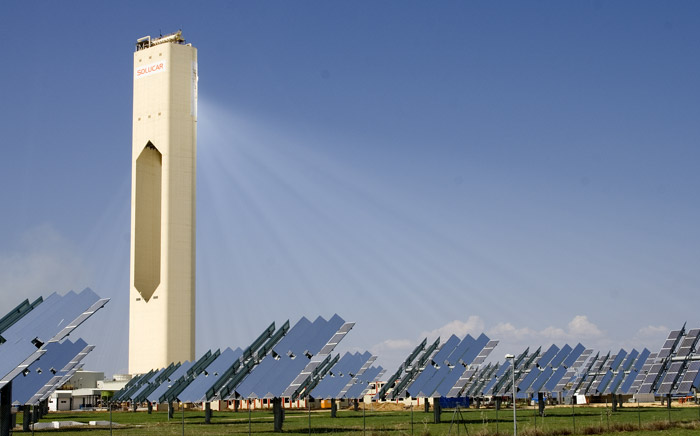Applications of Solar Technology:
Solar energy refers primarily to the use of solar radiation for practical ends. All other renewable energies other than geothermal derive their energy from the sun.

The PS10 concentrates sunlight from a field of heliostats on a central tower.
Solar technologies are broadly characterized as either passive or active depending on the way they capture, convert and distribute sunlight. Active solar techniques use photovoltaic panels, pumps, and fans to convert sunlight into useful outputs. Passive solar techniques include selecting materials with favorable thermal properties, designing spaces that naturally circulate air, and referencing the position of a building to the Sun. Active solar technologies increase the supply of energy and are considered supply side technologies, while passive solar technologies reduce the need for alternate resources and are generally considered demand side technologies
Architecture and Urban Planning:

Sunlight has influenced building design since the beginning of architectural history. Advanced solar architecture and urban planning methods were first employed by the Greeks and Chinese, who oriented their buildings toward the south to provide light and warmth.
The common features of passive solar architecture are orientation relative to the Sun, compact proportion (a low surface area to volume ratio), selective shading (overhangs) and thermal mass. When these features are tailored to the local climate and environment they can produce well-lit spaces that stay in a comfortable temperature range. Socrates' Megaron House is a classic example of passive solar design. The most recent approaches to solar design use computer modeling tying together solar lighting, heating and ventilation systems in an integrated solar design package. Active solar equipment such as pumps, fans and switchable windows can complement passive design and improve system performance.
Urban heat islands (UHI) are metropolitan areas with higher temperatures than that of the surrounding environment. The higher temperatures are a result of increased absorption of the Solar light by urban materials such as asphalt and concrete, which have lower albedos and higher heat capacities than those in the natural environment. A straightforward method of counteracting the UHI effect is to paint buildings and roads white and plant trees. Using these methods, a hypothetical "cool communities" program in Los Angeles has projected that urban temperatures could be reduced by approximately 3 °C at an estimated cost of US$1 billion, giving estimated total annual benefits of US$530 million from reduced air-conditioning costs and healthcare savings.
Electrical Generation:
Sunlight can be converted into electricity using photovoltaics (PV), concentrating solar power (CSP), and various experimental technologies. PV has mainly been used to power small and medium-sized applications, from the calculator powered by a single solar cell to off-grid homes powered by a photovoltaic array. For large-scale generation, CSP plants like SEGS have been the norm but recently multi-megawatt PV plants are becoming common. Completed in 2007, the 14 MW power station in Clark County, Nevada and the 20 MW site in Beneixama, Spain are characteristic of the trend toward larger photovoltaic power stations in the US and Europe.[67] As an intermittent power source, solar power requires a backup supply, which can partially be complemented with wind power. Local backup usually is done with batteries, while utilities normally use pumped-hydro storage. The Institute for Solar Energy Supply Technology of the University of Kassel pilot-tested a combined power plant linking solar, wind, biogas and hydrostorage to provide load-following power around the clock, entirely from renewable sources

